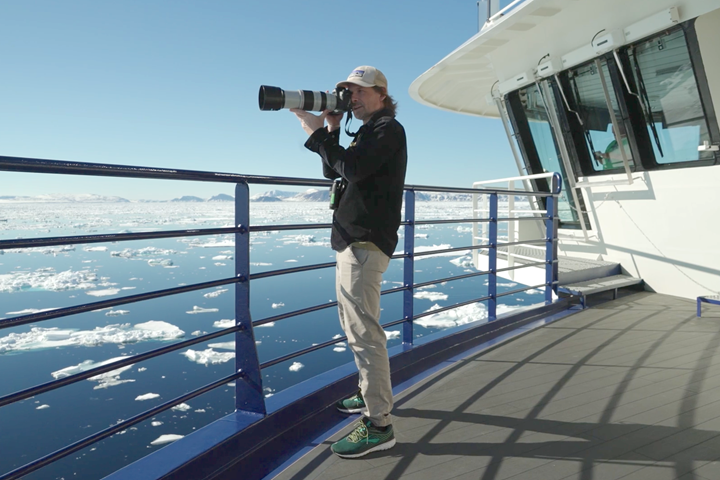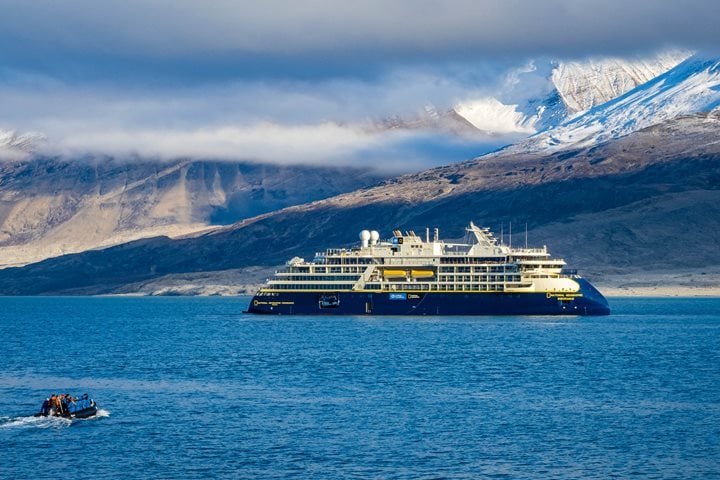Video Transcript
Eric Guth, Lindblad Expeditions Naturalist and Certified Photo Instructor: The Northwest Passage is one of the few places left on Earth where true exploration still exists.
This route through the high Arctic is ruled by ice, and expedition ships only come here when the ice allows it.
There's nothing like being on this state-of-the-art polar ship in such a dramatic environment, and it's this modern technology that allows us to pursue what many consider to be the ultimate Arctic expedition.
Title: What to Expect: Sailing the Northwest Passage
I’m Eric Guth, and I'm a naturalist and photo instructor with Lindblad Expeditions, and today I'm aboard the National Geographic Resolution sailing through the Northwest Passage.
The Northwest Passage is the sea route through an archipelago of islands which lie above the North American mainland. This passage links the Atlantic and Pacific oceans through a landscape of rocky terrain and tundra.
The quest to find the Northwest Passage goes back centuries. Silks and spices from the east had massive value and were highly coveted in European markets. Until a passage was found, the only routes to Asia were either slow overland journeys or long sea voyages.
In the summer months, there are really only a few navigable routes through the Northwest Passage due to the ice conditions. The most frequently used route, which is approximately 900 miles long, runs east to west—north of Baffin Island to the Beaufort Sea.
What is the Northwest Passage?
The Northwest Passage itinerary covers much ground, starting in Greenland and finishing in the Yukon. Along the way the ships make multiple stops, and the entire voyage takes about three weeks.
Glaciers cloak the slopes of the mountains and calve spectacular icebergs into the sea. It's a rugged train, with ice and snow all year round at higher elevations while offering spectacular hikes closer to sea level.
On our expedition through the Northwest Passage, we visit several indigenous communities. This gives us a chance to meet with locals, to learn more about modern Arctic culture, and to really engage with people that live up here. In addition, we also spend time at sites where 19th century explorers made landfall.
Time spent at the ship's digital chart will help identify the islands, landmarks, and waterways which bear the names of those who came searching for this elusive passage. Time spent on the bridge will afford you opportunities to hang out with naturalists who will be spending their time looking for wildlife.
What You'll See on a Northwest Passage Cruise
Wildlife in this part of the world is pretty elusive and we can't guarantee any sightings, but we'll certainly be up there helping you identify what we do see.
Ralph Lee Hopkins, Lindblad Expeditions Naturalist and Certified Photo Instructor: “Great spotters found the bear, and so we just parked in the ice. All the photographers were out on deck with their long lenses, and then it started rolling right in front of the ship.”
Eric Guth: Polar bears are the icons of the Arctic, and even though we're always on the hunt for polar bears, there are many other animals that also call this place home.
Seeing large numbers of walruses hauled out on land or floating on moving pack ice is unique to the Arctic regions. The creamy white belugas are easy to identify, while narwhals with their single twisted, sphere-like tooth, they're known as the unicorns of the sea.
They're often difficult to see partially because of the fact that they're hunted up here, and due to that, they're somewhat skittish and elusive, which is why seeing them is an incredible experience and one that is certainly fleeting.
Weather in the Arctic is unpredictable. It can rain one day and be snowy the next. Cold, katabatic winds can flow down the glacier faces leading to really chilly conditions. On other days, the clarity of the light is extraordinary, and the strength of the sun calls for sunscreen and sunglasses.
Sailing the Northwest Passage is a major highlight of our summer season in the Arctic. Being able to navigate these waterways on a polar vessel like this in genuine comfort is an absolute privilege.
We hope you join us, and we look forward to having you onboard soon.




